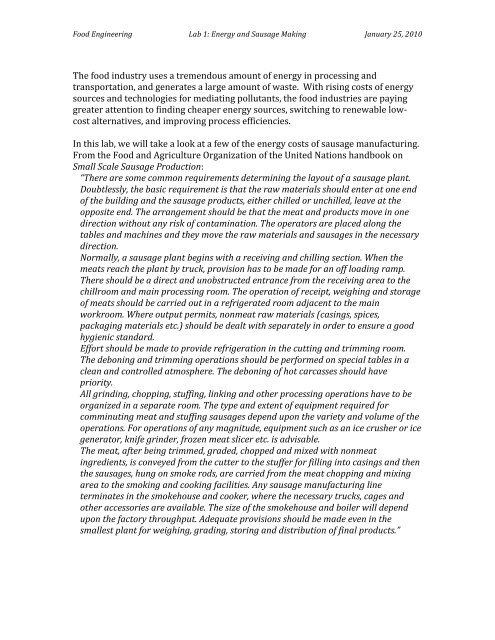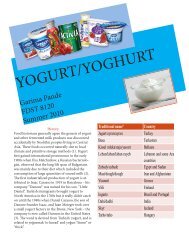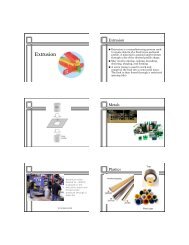Lab 2 Energy and Sausage.pdf
Lab 2 Energy and Sausage.pdf
Lab 2 Energy and Sausage.pdf
Create successful ePaper yourself
Turn your PDF publications into a flip-book with our unique Google optimized e-Paper software.
Food Engineering <strong>Lab</strong> 1: <strong>Energy</strong> <strong>and</strong> <strong>Sausage</strong> Making January 25, 2010<br />
The food industry uses a tremendous amount of energy in processing <strong>and</strong><br />
transportation, <strong>and</strong> generates a large amount of waste. With rising costs of energy<br />
sources <strong>and</strong> technologies for mediating pollutants, the food industries are paying<br />
greater attention to finding cheaper energy sources, switching to renewable low‐<br />
cost alternatives, <strong>and</strong> improving process efficiencies.<br />
In this lab, we will take a look at a few of the energy costs of sausage manufacturing.<br />
From the Food <strong>and</strong> Agriculture Organization of the United Nations h<strong>and</strong>book on<br />
Small Scale <strong>Sausage</strong> Production:<br />
“There are some common requirements determining the layout of a sausage plant.<br />
Doubtlessly, the basic requirement is that the raw materials should enter at one end<br />
of the building <strong>and</strong> the sausage products, either chilled or unchilled, leave at the<br />
opposite end. The arrangement should be that the meat <strong>and</strong> products move in one<br />
direction without any risk of contamination. The operators are placed along the<br />
tables <strong>and</strong> machines <strong>and</strong> they move the raw materials <strong>and</strong> sausages in the necessary<br />
direction.<br />
Normally, a sausage plant begins with a receiving <strong>and</strong> chilling section. When the<br />
meats reach the plant by truck, provision has to be made for an off loading ramp.<br />
There should be a direct <strong>and</strong> unobstructed entrance from the receiving area to the<br />
chillroom <strong>and</strong> main processing room. The operation of receipt, weighing <strong>and</strong> storage<br />
of meats should be carried out in a refrigerated room adjacent to the main<br />
workroom. Where output permits, nonmeat raw materials (casings, spices,<br />
packaging materials etc.) should be dealt with separately in order to ensure a good<br />
hygienic st<strong>and</strong>ard.<br />
Effort should be made to provide refrigeration in the cutting <strong>and</strong> trimming room.<br />
The deboning <strong>and</strong> trimming operations should be performed on special tables in a<br />
clean <strong>and</strong> controlled atmosphere. The deboning of hot carcasses should have<br />
priority.<br />
All grinding, chopping, stuffing, linking <strong>and</strong> other processing operations have to be<br />
organized in a separate room. The type <strong>and</strong> extent of equipment required for<br />
comminuting meat <strong>and</strong> stuffing sausages depend upon the variety <strong>and</strong> volume of the<br />
operations. For operations of any magnitude, equipment such as an ice crusher or ice<br />
generator, knife grinder, frozen meat slicer etc. is advisable.<br />
The meat, after being trimmed, graded, chopped <strong>and</strong> mixed with nonmeat<br />
ingredients, is conveyed from the cutter to the stuffer for filling into casings <strong>and</strong> then<br />
the sausages, hung on smoke rods, are carried from the meat chopping <strong>and</strong> mixing<br />
area to the smoking <strong>and</strong> cooking facilities. Any sausage manufacturing line<br />
terminates in the smokehouse <strong>and</strong> cooker, where the necessary trucks, cages <strong>and</strong><br />
other accessories are available. The size of the smokehouse <strong>and</strong> boiler will depend<br />
upon the factory throughput. Adequate provisions should be made even in the<br />
smallest plant for weighing, grading, storing <strong>and</strong> distribution of final products.”
Food Engineering <strong>Lab</strong> 1: <strong>Energy</strong> <strong>and</strong> <strong>Sausage</strong> Making January 25, 2010<br />
! "#$$%&'!(&)!$*%++%&',!<br />
! -!.!/0*1%&'!$(234!<br />
! 5!.!064*74()!*(%3!<br />
"7088%&'!(&)!+%9%&'!<br />
! :!.!+%94*!<br />
! ;!.!'*%&)4*!(&)!
Food Engineering <strong>Lab</strong> 1: <strong>Energy</strong> <strong>and</strong> <strong>Sausage</strong> Making January 25, 2010<br />
We will be making a Bratwurst sausage from pork <strong>and</strong> spices. The formula:<br />
The general process is :<br />
Pork 70% lean 20 lbs<br />
Black pepper 5.66 g<br />
Sage 3.96 g<br />
Ginger 2.83 g<br />
White pepper 2.26 g<br />
Corri<strong>and</strong>er 0.79 g<br />
Nutmeg 0.79 g<br />
Ground celery seed 0.68 g<br />
Carroway 0.68 g<br />
Cardamon 0.68 g<br />
Savory summer 0.28 g
Food Engineering <strong>Lab</strong> 1: <strong>Energy</strong> <strong>and</strong> <strong>Sausage</strong> Making January 25, 2010<br />
In addition to making sausage, we will be measuring energy use in the processing<br />
rooms <strong>and</strong> unit operations. Our three major tools will be:<br />
1. Power meters: for processes that rely on motors or other electrical input<br />
(mixers, choppers, conveyors, packaging machines) we will assess power use<br />
from measurement of the current (I) <strong>and</strong> voltage (V) delivered over the time<br />
of the operation. The equipment is plugged into a board from which we<br />
record both. The total power is given by<br />
Power = I V t<br />
This is only strictly true for DC circuits. Measuring AC power is much more<br />
complicated. As the current <strong>and</strong> voltage oscillate, <strong>and</strong> may even be out of<br />
phase, one needs to calculate the root‐mean‐square (RMS) voltage <strong>and</strong><br />
current. The real power is given by P = (Power factor)(Apparent power).<br />
We’ll disregard the roll of power factor for our estimate of power.<br />
2. Steam flow meters: a common means of measuring flow is the variable‐area<br />
meter, in which a tube with variable area contains a float that moves upward.<br />
Fluid causes the float to rise. As it moves up, more area is exposed around<br />
the float, <strong>and</strong> fluid can move around the float. At some point, a dynamic<br />
equilibrium is reached between the upward pressure difference <strong>and</strong><br />
buoyancy, countered by the downward force of gravity on the float. The<br />
height of the flow measures the flow rate.
Food Engineering <strong>Lab</strong> 1: <strong>Energy</strong> <strong>and</strong> <strong>Sausage</strong> Making January 25, 2010<br />
We will also get an estimate of power consumption in the cold room. The power<br />
requirements of the lights will be estimated by counting the number of lights <strong>and</strong><br />
multiplying by the bulb wattage.<br />
TO DO:<br />
The sausage production will be demonstrated in the lab. Meters will be provided to<br />
determine electric <strong>and</strong> steam consumption. The class will be divided into groups,<br />
with each group assigned a task.<br />
Group 1: Cut <strong>and</strong> trim meat. Measure electrical consumption of devices with<br />
motors.<br />
Group 2: Measure out dry ingredients. Package representative samples. Count<br />
lights in processing room <strong>and</strong> determine bulb wattage.<br />
Group 3: Operate bowl chopper <strong>and</strong> stuffer. Measure steam use.<br />
Group 4: Cook meat by steam. Determine going costs for steam <strong>and</strong> electricity.<br />
REPORT:<br />
1. Make a table of the energy use for the following parts of the process: (1)<br />
cooling room, (2) bowl chopper, (3) stuffer, (4) steam cooker, (5) packaging<br />
machine, (6) electrical lights, <strong>and</strong> any other sources of energy use we<br />
determined. Also estimate the total costs for each operation.<br />
2. Determine the ingredient total costs per pound of the product.<br />
3. Estimate the total costs per pound of product<br />
4. Make a pie chart of the relative contributions of ingredients <strong>and</strong> each of the<br />
energy costs to the product costs.<br />
Questions:<br />
1. What was the most energy intensive part of the process?<br />
2. Were there any parts of the process where we might have saved on energy<br />
use? If so, which parts?





